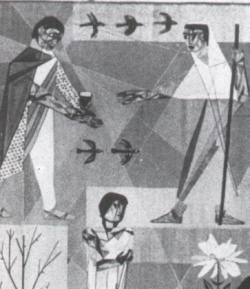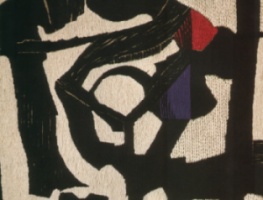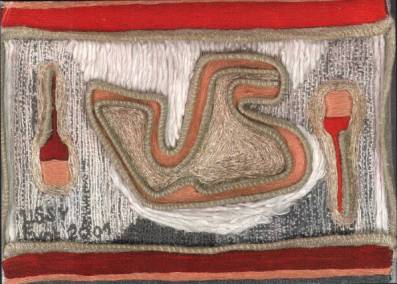| |
Lissy now moved increasingly
toward abstraction. Abstraction allows her many more
options for more complex and involving images. Her work
seems charged with energy and rhythm, it is an evocative
image free from the limits that realistic appearances can
impose. Her preoccupation with light and times of the
day is another theme in Lissy’s work. Il Mattino
(dawn) (160 x 61cm, 1978), la Mattinata
(the morning song) (180 x 153cm, 1975) show the beginning
of the day. Upright forms in blue and black suggest the
transformation from night to day. La Giornata (185
x 200, 1980) features a dramatic maze of intersecting
black lines. One senses the many interruptions and moods
one experiences in a day. Morning and Evening Light
(210 x ll5cm, 1987). shows the struggle between
the foreboding darkness of night and the purity and
promise of the early day. Here Lissy has achieved an
incandescent and ethereal quality that one would never
expect from needle and thread.
These pieces become all the more remarkable when one
realizes that they are entirely embroidered. They are all
embroidered wall hangings. Lissy’s controll over
needle and thread is extraordinary.
Sources of inspiration were her travels to Italy, to
France. Throughout her career, she kept abreast of
|
|
the European and American
art scene by attending international exhibitions in
Switzerland. Another source has been the art and eye of
her husband Adolf Funk. their relationship and work have
been enriched by constant intellectual interchange, along
with great affection and concern for one another. Important
were Lissy’s participation in the International
Tapestry Biennales in Lausanne, Switzerland of 1965, 1969
and 1977. Lissy’s work was also included 1986 in the
exhibition of Gruppe 78, an association formed in 1978 by
Swiss textile artists, all of them woman. In 1988 a
Retrospective was held in the Art Institute of Chicago
USA, in 1989 the same exhibition was shown in Krefeld
Germany and in Zürich. 2 years ago some of her important
works and a number of small-scale works were shown in
Winterthur and in the Textile Museum in St. Gallen
Switzerland.
Lissy began to produce small-scale works in 1976,
calling them Minis and Mini-minis. For the St.Gallen
exhibition she created a number of new ones. She can
reach a wider audience with these more affordable works,
but despite the smaller scale the creative procedure is
the same as in her bigger wall hangings:
clasping hands 1994, full of life 1993, the
circle 1996, many together 1996, upright 1996,
Valentins day 1996.
|




